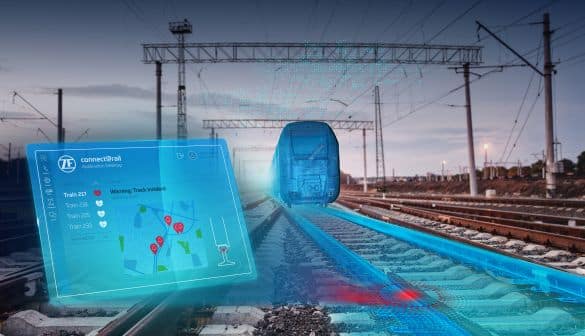Digital monitoring detects rail defects
WITH the rail network under pressure from many factors including extreme weather, high utilisation and everyday wear, it is important to monitor the condition of track precisely and effectively.
With a new track monitoring feature, ZF has enhanced its connect@rail condition monitoring platform to increase the efficiency of monitoring critical infrastructure. The digital monitoring solution detects potential rail defects at an early stage. This enables predictive and flexible planning of maintenance work, thus reducing unnecessary expense, preventing delays and failures, and offering real added value in terms of safety and comfort.
The condition monitoring function is based on ZF heavy-duty tags. Mounted on the wheelset bearing cover or on the bogie, the Bluetooth sensors record acceleration data at the wheels and transmit it to telematics gateways. The information is aggregated here before being sent to the ZF Cloud for evaluation. Customers view this data via a customer-specific dashboard, enabling them to undertake predictive maintenance as required.
Fast charging for battery trains
THE range of battery-electric trains is currently limited when operating on non-electrified lines, requiring the use of charging infrastructure such as short sections of overhead catenary. To mitigate this issue and accelerate the use of battery trains on non-electrified lines, Stadtwerke Tübingen, Germany, and Furrer+Frey, Switzerland, developed the Voltap battery fast charging station which can provide electrical power of up to 1.2MW per vehicle.
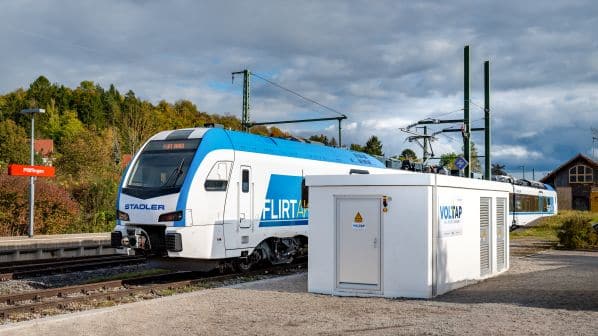
Unlike partial electrification, Voltap requires only a few metres of overhead catenary and allows trains to be charged while stationary. This also enables trains to be distributed on different phases of the substation, minimising the impact on the voltage imbalance of the feeding three-phase grid. This also removes the need for power electronics to counteract the voltage imbalance issue.
If requirements change in the future, the charging station can also be easily relocated to a different location, creating maximum flexibility.
In this way, Voltap’s innovative approach enables a universally applicable charging solution for all use cases, including fast charging or slow overnight charging, for passenger or freight vehicles.
Engine off, efficiency on
LOADING and unloading can result in long waiting times for rail freight operators. As a consequence, the engines of shunting locomotives are operated at idle for up to 70% of their service life. Voith has developed the OnEfficiency.StopStart automatic stop-start system, which can produce high operational savings by switching off the engine when the locomotive is stationary for prolonged periods.
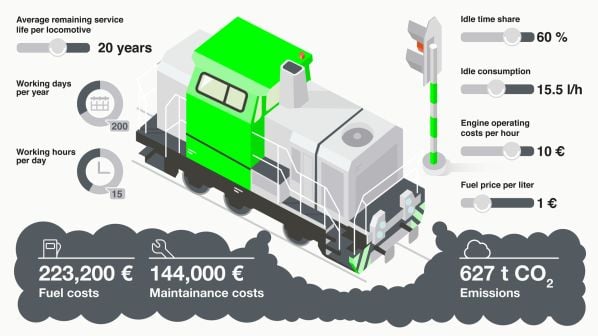
The stop-start technology reduces the idle time of the engine by 720 hours per year on average, offering an average fuel saving of up to 11,000 litres per engine every year, resulting in lower fuel costs and fewer refuelling stops. It can also save up to 30,000kg of CO2 per locomotive.
In principle, OnEfficiency.StopStart is compatible with all diesel locomotives that are already equipped with an electronic control system. For G1000 and G1206 type locomotives, Voith already offers a standardised solution that can be implemented quickly and easily, while standardisation for further locomotive types is already in progress.
Automating track geometry measurement
WITH the track geometry market continuing to embrace increased automation and integration, infrastructure managers are looking for systems that allow them to own and operate their own track maintenance machines. For this, portable inspection systems such as Holland’s Track Inspector complement traditional geometry collection in areas such as depots and branch lines.
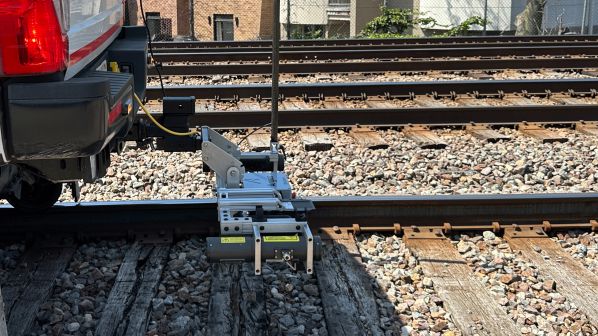
The Track Inspector is a full geometry system and can be mounted, configured and calibrated by one person in less than an hour. Usable with any conventional road-rail vehicle with any size trailer hitch, the Track Inspector provides a dedicated manned track measurement vehicle with a wireless connection between the system and an onboard tablet.
These units feature a lightweight and foldable mounting design which comes with a convenient travel and storage case.
At the heart of the system is Holland’s Argus track measurement technology, which replaces a conventional wheel-mounted encoder with a non-contact speed and distance measurement device to remove hardware reliability issues.
Complete rail operation integration
IVU has developed a fully integrated control centre system that supplies passengers with consistent up-to-date information across all channels. This new system supports a continuous digital workflow at every step, from timetable planning and dispatch to disruption management and the supply of real-time information.
Operators encounter a number of challenges at operations control centres every day. Personnel absences at short notice, vehicle restrictions, high passenger volumes, and damage to the track are all factors that need to be considered. Decisions made by the infrastructure manager can also influence the reliability of train operations.
In the event of disruption, IVU’s incident management solution provides extensive support, with standardised documentation in the control centre log. Meanwhile, comprehensive integration with vehicle systems ensures that onboard systems that support functions such as passenger counting, interior monitoring, and passenger information systems work together smoothly.
The IVU.rail control centre system standardises data flows, helping to harmonise different sources of information from applications that support planning to personnel and vehicle dispatch to onboard software. At the same time, the system transmits all real-time information directly to the passengers.
Real-time planning tool transforms yard operations
WABTEC has developed the Yard Planner system in response to the rail industry’s need for decision-support tools that enhance manual planning by yard managers and to drive new levels of operational consistency.
Marshalling yards play an important role in the rail network. Separating and sorting wagons and forming new outbound trains are central to delivery performance. With an estimated 50% of wagons passing through yards, these transport nodes impact departure performance, cycle time, and operational efficiency. Yet, today, much of the work being done in yard is manual and inefficient.
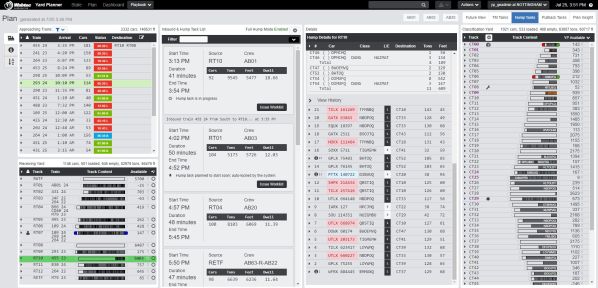
Yard Planner combines dynamic planning tools, increased visibility, and powerful decision support to help railways make the best decisions on asset use and resource allocation so they can get wagons out of the yard faster.
A key innovation is the use of forward-looking planning algorithms that consider all inbound traffic for the next 12 hours, plan hump and shunting operations as well as train formation tasks for the next eight hours, and generate a new plan every two minutes or less.
This enables proactive planning to be completed hours before a task is executed and frees up yard managers to manage any unforeseen events and crew deployment.
In addition, by connecting and integrating multiple yard systems, Yard Planner sets the stage for future automation and network efficiency across the rail network.
Introducing pay-as-you-go ticketing to improve passenger journeys
FAIRTIQ has developed a seamless Mobile Postpaid pay-as-you-go (PAYG) ticketing system app which already covers Switzerland and Liechtenstein as well as parts of Germany, Austria and France.
Passengers check in via the app before boarding and check out upon arrival, with the app accurately calculating the best available fare. Large-scale implementation has demonstrated Fairtiq’s ability to handle detailed functional requirements, processes such as fraud mitigation, and services such as customer care at scale.

In 2023, Fairtiq introduced Companion Mode, enabling groups and families to travel together with a single smartphone.
The system can also support innovative fare schemes, and allow regions to test and adopt beeline tariffs based on the linear distance between stops, as well as daily, weekly or monthly price caps, and flexible fare models. The Occitanie region in France has collaborated with Fairtiq to create fares tailored to different user groups, which increased revenue and ridership.
Part 2 of IRJ Innovations Showcase 2023 can be found here
Part 3 of IRJ Innovations Showcase 2023 can be found here
Part 4 of IRJ Innovations Showcase 2023 can be found here
